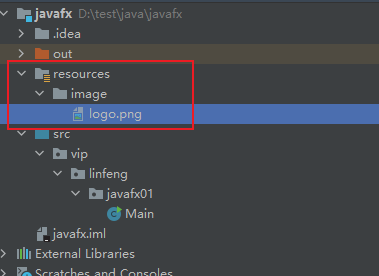还在为Java无法写客户端而烦恼吗?不要怕,大胆的拥抱JavaFX吧!保证让你从入门到放弃!
最简单的项目
来,让我们创建一个最简单的JavaFX项目吧
创建项目
从官网下载JavaFX依赖
回到项目中,File-Project Structure...-libraries-加号-你JavaFX解压后的路径/bin下的所有jar包
创建启动类
package vip.linfeng.javafx01;
import javafx.application.Application;
import javafx.stage.Stage;
public class Main extends Application {
public static void main(String[] args) {
Application.launch(args);
}
@Override
public void start(Stage stage) throws Exception {
// 设置title
stage.setTitle("林风测试");
// 显示窗口
stage.show();
}
}启动项目(配置参数)
然后,当你第一次启动时估计会报错:
错误: 缺少 JavaFX 运行时组件, 需要使用该组件来运行此应用程序不慌,咱们直接配置一下vm虚拟机的参数
点击项目-Edit Configurations...-Modify options-Add VM options-在VM options中配置下面参数(注意:路径要写你解压的路径)
--module-path "D:\lib\sdk\javafx-sdk-21.0.7\lib" --add-modules javafx.controls,javafx.fxml最后ctrl+shift+F10完美运行
基本代码
当你准备好后,你就可以开始愉快的敲代码啦!
首先,写个最基本的标签、布局、场景、窗口
public class Main extends Application {
public static void main(String[] args) {
Application.launch(args);
}
@Override
public void start(Stage stage) throws Exception {
// 创建标签
Label label = new Label("你好呀");
// 创建布局,并将标签扔到布局中
BorderPane pane = new BorderPane(label);
// 创建场景,并将布局扔到场景中,并设置宽高
Scene scene = new Scene(pane, 300, 300);
// 将场景设置到窗口中
stage.setScene(scene);
// 设置title
stage.setTitle("林风测试");
// 显示窗口
stage.show();
}
}运行结果如下:
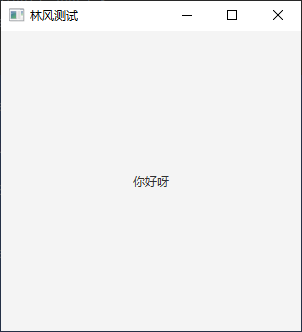
完美!
基础部分
我先撂下官方文档
这里不过多解释各种控件用法和方法事件,我感觉只需要看官方的文档就足够了
Application类执行顺序
通过main()执行Application的launch(String str)方法,当然launch(String str)方法不传入任何值也是可以执行的.launch(String str)方法会默认执行本类下的init()、start()、stop()方法。执行下面的main()方法后显示顺序为:
这是初始化方法->这是start()方法->这是stop()方法->这是main()方法。
举例
public class Main extends Application {
public static void main(String[] args) {
Application.launch(args);
}
@Override
public void start(Stage stage) throws Exception {
System.out.println("这是start方法");
// 设置title
stage.setTitle("林风测试");
// 显示窗口
stage.show();
}
@Override
public void init() throws Exception {
super.init();
System.out.println("这是init方法");
}
@Override
public void stop() throws Exception {
super.stop();
System.out.println("这是stop方法");
}
}运行结果:
这是init方法
这是start方法
这是stop方法按钮组件及其单击事件
public class Main extends Application {
public static void main(String[] args) {
Application.launch(args);
}
@Override
public void start(Stage stage) throws Exception {
// 创建按钮组件
Button button = new Button("有种你点我啊");
// 创建布局并将按钮扔进去
BorderPane pane = new BorderPane(button);
// 设置按钮单击事件
button.setOnAction(e -> {
getHostServices().showDocument("http://blog.linfeng.vip");
});
// 创建场景并把布局扔进去,并设置宽高
Scene scene = new Scene(pane, 300, 300);
// 将场景扔到舞台
stage.setScene(scene);
// 设置标题
stage.setTitle("林风最帅");
// 显示窗口
stage.show();
}
}Stage类
Title:设置title标题文本
icon:设置窗口图标
resiziable:窗口是否可以改变大小
x,y,width,height:设置坐标和宽高,不常用
StageStyle:窗口风格样式
Modality:是否为模态窗口
event:窗口事件,关闭、最大化、最小化等等,不常用
案例
@Override
public void start(Stage stage) throws Exception {
Button button0 = new Button("窗口0");
Button button1 = new Button("窗口1");
// 设置按钮位置
button0.setLayoutX(200);
button0.setLayoutY(200);
button1.setLayoutX(200);
button1.setLayoutY(250);
// 创建锚定容器
AnchorPane pane = new AnchorPane();
pane.getChildren().addAll(button0, button1);
button0.setOnAction(e -> {
Stage stage0 = new Stage();
stage0.setHeight(200);
stage0.setWidth(300);
// APPLICATION_MODAL该应用只能有这一个模态框,只能在该模态框操作,其它任何窗口都无法操作
// stage1.initModality(Modality.APPLICATION_MODAL);
// 设置父窗口
stage0.initOwner(stage);
// WINDOW_MODAL表示,只有父窗口是禁用的,其它窗口都可以使用
stage0.initModality(Modality.WINDOW_MODAL);
stage0.show();
});
button1.setOnAction(e -> {
Stage stage1 = new Stage();
stage1.setHeight(200);
stage1.setWidth(300);
stage1.show();
});
Scene scene = new Scene(pane, 500, 500);
stage.setScene(scene);
// 设置标题
stage.setTitle("林风最帅");
// 设置窗口图标,从窗口中获取Icons然后添加一个Image实例即可
stage.getIcons().add(new Image("image/logo.png"));
// 锁定窗口大小,禁止用户改变窗口大小,包括最大化,默认允许
stage.setResizable(false);
// 设置窗口风格样式
// 注意:UNDECORATED在没有场景的情况下什么都不显示
stage.initStyle(StageStyle.UNDECORATED);
// 显示窗口
stage.show();
}图片路径:
StageStyle和Modality
StageStyle风格
舞台具有以下样式之一:
StageStyle.DECORATED- 具有纯白色背景和平台装饰的舞台。(默认)StageStyle.UNDECORATED- 具有纯白色背景且没有任何装饰的舞台。StageStyle.TRANSPARENT- 背景透明且无任何装饰的舞台。StageStyle.UTILITY- 具有纯白色背景和极简平台装饰的舞台。
Modality
Modality.APPLICATION_MODAL:定义一个模式窗口,阻止事件传递到任何其他应用程序窗口。Modality.NONE:定义一个非模态且不阻塞任何其他窗口的顶级窗口。(默认)Modality.WINDOW_MODAL:定义一个模式窗口,阻止事件传递到其整个所有者窗口层次结构。
Event
窗口事件,为减少代码看着不那么乱,单独拎出来了
@Override
public void start(Stage stage) throws Exception {
Button button = new Button("窗口");
button.setLayoutX(200);
button.setLayoutY(200);
AnchorPane pane = new AnchorPane();
pane.getChildren().addAll(button);
// 关闭操作系统默认退出程序操作
Platform.setImplicitExit(false);
stage.setOnCloseRequest(e -> {
// 关闭操作系统默认关闭窗口操作
e.consume();
// 弹出窗口询问是否关闭窗口
// 若是则退出,不是则无操作
Alert alert = new Alert(Alert.AlertType.CONFIRMATION);
alert.setTitle("退出程序");
alert.setHeaderText(null);
alert.setContentText("您是否要退出程序?");
Optional<ButtonType> result = alert.showAndWait();
if(result.get() == ButtonType.OK) {
// 退出程序并关闭窗口
Platform.exit();
// 下面的代码仅仅是关闭窗口,并没有结束进程
// stage.close();
}
});
Scene scene = new Scene(pane, 500, 500);
stage.setScene(scene);
stage.setTitle("林风最帅");
stage.show();
}页面场景切换及其鼠标图片样式
示例代码:
@Override
public void start(Stage stage) throws Exception {
// 编写第一个场景
Button button0 = new Button("hello world!");
button0.setLayoutX(200);
button0.setLayoutY(200);
AnchorPane root = new AnchorPane();
root.getChildren().addAll(button0);
Scene scene = new Scene(root, 500, 500);
// 给第一个场景设置鼠标图片,用来替换原鼠标样式
scene.setCursor(new ImageCursor(new Image(getClass().getResourceAsStream("/image/cursor1.png"))));
// 编写第二个场景
Label label = new Label("你好,世界!");
label.setLayoutX(200);
label.setLayoutY(200);
Button button1 = new Button("返回原参数页面");
button1.setLayoutX(200);
button1.setLayoutY(250);
AnchorPane root1 = new AnchorPane();
root1.getChildren().addAll(label, button1);
Scene scene1 = new Scene(root1, 500, 500);
// 给第二个场景设置鼠标图片,用来替换原鼠标样式
scene1.setCursor(new ImageCursor(new Image(getClass().getResourceAsStream("/image/cursor.png"))));
// 页面切换逻辑
// 其实就是把场景进行替换
button0.setOnAction(e -> {
stage.setScene(scene1);
});
button1.setOnAction(e -> {
stage.setScene(scene);
});
stage.setScene(scene);
stage.setTitle("林风测试");
stage.getIcons().addAll(new Image("image/logo.png"));
stage.show();
}Node类
Node类是一个抽象类,其所有控件或其父类都继承的Node类
layoutX/layoutY/preWidth/preHeight
style/visible/opacity/blendMode
tanslateX/tanslateY/rotate/scaleX/scaleY/scaleZ
parent/scene/id
案例一:layoutX/layoutY/preWidth/preHeight、style
@Override
public void start(Stage stage) throws Exception {
Label label = new Label("Hello world");
// 设置坐标
label.setLayoutX(200);
label.setLayoutY(200);
// 设置样式: 跟css一样,红色背景,蓝色边框,边框宽度3像素
label.setStyle("-fx-background-color: red; -fx-border-color: blue; -fx-border-width: 3px;");
// 设置宽高
label.setPrefWidth(200);
label.setPrefHeight(80);
// 设置label的内容居中
label.setAlignment(Pos.CENTER);
AnchorPane root = new AnchorPane();
root.getChildren().addAll(label);
Scene scene = new Scene(root, 500, 500);
stage.setScene(scene);
stage.show();
}案例二:visible/opacity/rotate/translateX/translateY
@Override
public void start(Stage stage) throws Exception {
Label label = new Label("Hello world");
// 设置样式
label.setPrefWidth(200);
label.setPrefHeight(200);
label.setAlignment(Pos.CENTER);
label.setStyle("-fx-background-color: red;");
// 设置透明度
label.setOpacity(0.5);
// 旋转45度
label.setRotate(45);
// 平移
label.setTranslateX(100);
label.setTranslateY(50);
// 不显示控件
label.setVisible(false);
AnchorPane root = new AnchorPane();
root.getChildren().addAll(label);
Scene scene = new Scene(root, 500, 500);
stage.setScene(scene);
stage.show();
}UI控件的属性绑定和属性监听
Property接口:在Node中几乎所有的属性都使用的Property子类的实例
案例:让一个圆形居中,并监听Y轴变化输出
@Override
public void start(Stage stage) throws Exception {
Circle circle = new Circle();
circle.setCenterX(250);
circle.setCenterY(250);
circle.setRadius(100);
circle.setStroke(Color.BLACK);
circle.setFill(Color.WHITE);
AnchorPane root = new AnchorPane();
Scene scene = new Scene(root, 500, 500);
// 创建单项绑定
circle.centerXProperty().bind(scene.widthProperty().divide(2));
circle.centerYProperty().bind(scene.heightProperty().divide(2));
// 监听器,当Y轴改变时触发
circle.centerYProperty().addListener(new ChangeListener<Number>() {
@Override
public void changed(ObservableValue<? extends Number> observableValue, Number oldValue, Number newValue) {
System.out.println("Y轴改变,原来值为:" + oldValue + " 现在值为:" + newValue);
}
});
root.getChildren().addAll(circle);
stage.setScene(scene);
stage.show();
}JavaFX中的事件驱动编程
Node抽象类中有很多事件
案例一:点击事件和键盘事件
@Override
public void start(Stage stage) throws Exception {
AnchorPane root = new AnchorPane();
Label label = new Label("你好");
label.setLayoutX(200);
label.setLayoutY(200);
Button button = new Button("向上移动");
button.setLayoutX(200);
button.setLayoutY(250);
// 设置按钮点击事件
button.setOnAction(new EventHandler<ActionEvent>() {
@Override
public void handle(ActionEvent actionEvent) {
label.setLayoutY(label.getLayoutY() - 5);
}
});
root.getChildren().addAll(label, button);
Scene scene = new Scene(root, 500, 500);
// 设置键盘抬起的时候
scene.setOnKeyReleased(e -> {
KeyCode keyCode = e.getCode();
if(keyCode.equals(KeyCode.DOWN)){
System.out.println("aaaa");
// 按下了向下的箭头
label.setLayoutY(label.getLayoutY() + 5);
}
});
stage.setScene(scene);
stage.show();
}案例二:文件拖拽事件
@Override
public void start(Stage stage) throws Exception {
AnchorPane root = new AnchorPane();
Scene scene = new Scene(root, 500, 500);
TextField textField = new TextField();
textField.setLayoutX(150);
textField.setLayoutY(200);
// 定义一个当拖动手势在此范围内进行时要调用的函数Node。
textField.setOnDragOver(e -> {
// 传输模式:any表示包含所有传输模式的数组。
e.acceptTransferModes(TransferMode.ANY);
});
// 松开手之后
textField.setOnDragDropped(e -> {
Dragboard dragboard = e.getDragboard();
// 如果有文件
if(dragboard.hasFiles()){
// 获取文件路径
String path = dragboard.getFiles().get(0).getAbsolutePath();
textField.setText(path);
}
});
root.getChildren().addAll(textField);
stage.setScene(scene);
stage.show();
}Color、Font和Image
Color
Color.颜色Color.rgb(red, green, blue, alpha)Color.hsb(a,b,c,d):色相饱和度明度不透明度Color.web("#ffffff"):参考css
案例
@Override
public void start(Stage stage) throws Exception {
AnchorPane root = new AnchorPane();
Scene scene = new Scene(root, 500, 500);
Circle circle = new Circle();
circle.setCenterX(250);
circle.setCenterY(250);
circle.setRadius(100);
// 设置填充色:红色,不透明度0.5
circle.setFill(Color.web("#f00", 0.5));
// 设置边框颜色:蓝色,不透明度0.5
circle.setStrokeWidth(10);
circle.setStroke(Color.rgb(0, 0, 255, 0.5));
root.getChildren().addAll(circle);
stage.setScene(scene);
stage.show();
}Font
font(double size)
font(String family)
font(String family, double size)
font(String family, FontPosture posture, double size)
font(String family, FontWeight weight, double size)
font(String family, FontWeight weight, FontPosture posture, double size)案例:
// 设置字体大小
label.setFont(new Font(30));Image
用法:
Image(InputStream is)
Image(String url)
Image(String url, boolean backgroundLoading)案例:
@Override
public void start(Stage stage) throws Exception {
AnchorPane root = new AnchorPane();
Scene scene = new Scene(root, 500, 500);
ImageView imageView = new ImageView();
Image image = new Image(getClass().getResourceAsStream("/image/logo.png"));
imageView.setImage(image);
root.getChildren().addAll(imageView);
stage.setScene(scene);
stage.show();
}恭喜你,到这里基础的部分就算完结了,你现在可以写一些简单的小软件了
进阶部分
FXML布局文件的使用
先看下纯Java的代码:
@Override
public void start(Stage stage) throws Exception {
Label label = new Label("Hello world");
label.setLayoutX(150);
label.setLayoutY(200);
label.setFont(new Font(30));
Button button = new Button("向上移动");
button.setLayoutX(150);
button.setLayoutY(260);
button.setOnAction(e -> label.setLayoutY(label.getLayoutY() - 5));
AnchorPane root = new AnchorPane();
root.getChildren().addAll(label, button);
Scene scene = new Scene(root, 500, 500);
stage.setScene(scene);
stage.show();
}我们现在在项目的Java文件路径下创建一个FXML文件:
<?xml version="1.0" encoding="UTF-8"?>
<?import java.lang.*?>
<?import java.util.*?>
<?import javafx.scene.*?>
<?import javafx.scene.control.*?>
<?import javafx.scene.layout.*?>
<?import javafx.scene.text.Font?>
<AnchorPane xmlns="http://javafx.com/javafx"
xmlns:fx="http://javafx.com/fxml"
fx:controller="vip.linfeng.javafx01.DemoController"
prefHeight="400.0" prefWidth="600.0">
<children>
<Label fx:id="la"
text="Hello world"
layoutX="150"
layoutY="200">
<font>
<Font size="30" />
</font>
</Label>
<Button fx:id="bu"
onAction="#onUp"
text="向上移动"
layoutX="150"
layoutY="260" />
</children>
</AnchorPane>然后创建一个controller文件
public class DemoController {
@FXML
Label la;
@FXML
Button bu;
public void onUp() {
la.setLayoutY(la.getLayoutY() - 5);
}
}最后简化主类
public class Main extends Application {
public static void main(String[] args) {
Application.launch(args);
}
@Override
public void start(Stage stage) throws Exception {
Pane root = FXMLLoader.load(getClass().getResource("Demo.fxml"));
Scene scene = new Scene(root, 500, 500);
stage.setScene(scene);
stage.show();
}
}运行一下,完美~
最后附上结构图:
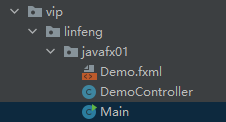
知识补充
其实到上面就已经可以了,你现在可以写一些中小型项目,只要你会看文档就行,官方的文档是个好东西,会用会查那么80%的难题都不在话下。然后有一些比较常用的知识补充一下:
initialize方法
public class OneController {
@FXML
Button btn;
@FXML
void action(ActionEvent e) {
System.out.println("行,你有种");
}
/**
* 初始化事件
* 可以用来绑定一些复杂的操作或做一些复杂的操作
*/
public void initialize() {
}
}Maven项目
是不是感觉找各种依赖包特别麻烦?尤其当你好不容易把所有依赖包一个个下载完后,一运行发现,版本冲突,天塌了!
所以这次教你将JavaFX用Maven进行管理
这里我就不再重建项目了,偷个小懒,把之前项目的pom.xml端上来吧
<?xml version="1.0" encoding="UTF-8"?>
<project xmlns="http://maven.apache.org/POM/4.0.0"
xmlns:xsi="http://www.w3.org/2001/XMLSchema-instance"
xsi:schemaLocation="http://maven.apache.org/POM/4.0.0 http://maven.apache.org/xsd/maven-4.0.0.xsd">
<modelVersion>4.0.0</modelVersion>
<groupId>site.hsdj</groupId>
<artifactId>accessexcel</artifactId>
<version>1.0</version>
<packaging>jar</packaging>
<properties>
<maven.compiler.source>17</maven.compiler.source>
<maven.compiler.target>17</maven.compiler.target>
<project.build.sourceEncoding>UTF-8</project.build.sourceEncoding>
<!-- JavaFX版本 -->
<javafx-version>21.0.7</javafx-version>
<!-- ucanaccess版本 -->
<u-can-access-version>5.0.1</u-can-access-version>
<!-- dbutils版本 -->
<commons-dbutils-version>1.7</commons-dbutils-version>
<!-- POI版本 -->
<poi-version>5.2.3</poi-version>
<!-- log4j2版本 -->
<log4j2-version>2.20.0</log4j2-version>
<!-- commons-lang3版本 -->
<commons-lang3-version>3.12.0</commons-lang3-version>
<!-- lombok版本 -->
<lombok-version>1.18.30</lombok-version>
<!-- 请求依赖版本 -->
<apache-httpcomponents>4.5.13</apache-httpcomponents>
<!-- jackson版本 -->
<jackson-version>2.18.2</jackson-version>
<!-- yaml解析器版本 -->
<snakeyaml-version>2.4</snakeyaml-version>
<snakeyaml-engine-version>2.9</snakeyaml-engine-version>
</properties>
<dependencies>
<!-- JavaFX依赖 -->
<dependency>
<groupId>org.openjfx</groupId>
<artifactId>javafx-controls</artifactId>
<version>${javafx-version}</version>
</dependency>
<dependency>
<groupId>org.openjfx</groupId>
<artifactId>javafx-graphics</artifactId>
<version>${javafx-version}</version>
</dependency>
<dependency>
<groupId>org.openjfx</groupId>
<artifactId>javafx-base</artifactId>
<version>${javafx-version}</version>
</dependency>
<dependency>
<groupId>org.openjfx</groupId>
<artifactId>javafx-fxml</artifactId>
<version>${javafx-version}</version>
</dependency>
<!-- access依赖 -->
<dependency>
<groupId>net.sf.ucanaccess</groupId>
<artifactId>ucanaccess</artifactId>
<version>${u-can-access-version}</version>
<scope>runtime</scope>
</dependency>
<dependency>
<groupId>commons-dbutils</groupId>
<artifactId>commons-dbutils</artifactId>
<version>${commons-dbutils-version}</version>
</dependency>
<!-- POI依赖 -->
<dependency>
<groupId>org.apache.poi</groupId>
<artifactId>poi</artifactId>
<version>${poi-version}</version>
</dependency>
<dependency>
<groupId>org.apache.poi</groupId>
<artifactId>poi-ooxml</artifactId>
<version>${poi-version}</version>
</dependency>
<!-- log4j2核心依赖,用于关闭报错,满足POI依赖 -->
<dependency>
<groupId>org.apache.logging.log4j</groupId>
<artifactId>log4j-core</artifactId>
<version>${log4j2-version}</version>
</dependency>
<!-- log4j2api依赖,用于可以正常使用log4j2 -->
<dependency>
<groupId>org.apache.logging.log4j</groupId>
<artifactId>log4j-api</artifactId>
<version>${log4j2-version}</version>
</dependency>
<!-- 常用工具包 -->
<dependency>
<groupId>org.apache.commons</groupId>
<artifactId>commons-lang3</artifactId>
<version>${commons-lang3-version}</version>
</dependency>
<!-- Lombok依赖 -->
<dependency>
<groupId>org.projectlombok</groupId>
<artifactId>lombok</artifactId>
<version>${lombok-version}</version>
<scope>provided</scope>
</dependency>
<!-- 请求依赖 -->
<dependency>
<groupId>org.apache.httpcomponents</groupId>
<artifactId>httpclient</artifactId>
<version>${apache-httpcomponents}</version>
</dependency>
<dependency>
<groupId>org.apache.httpcomponents</groupId>
<artifactId>httpmime</artifactId>
<version>${apache-httpcomponents}</version>
</dependency>
<!-- Jackson -->
<dependency>
<groupId>com.fasterxml.jackson.core</groupId>
<artifactId>jackson-databind</artifactId>
<version>${jackson-version}</version>
</dependency>
<dependency>
<groupId>com.fasterxml.jackson.core</groupId>
<artifactId>jackson-core</artifactId>
<version>${jackson-version}</version>
</dependency>
<dependency>
<groupId>com.fasterxml.jackson.core</groupId>
<artifactId>jackson-annotations</artifactId>
<version>${jackson-version}</version>
</dependency>
<!-- yaml解析器 -->
<dependency>
<groupId>org.yaml</groupId>
<artifactId>snakeyaml</artifactId>
<version>${snakeyaml-version}</version>
</dependency>
</dependencies>
<build>
<plugins>
<!-- 指定主类 -->
<plugin>
<groupId>org.apache.maven.plugins</groupId>
<artifactId>maven-jar-plugin</artifactId>
<version>3.3.0</version>
<configuration>
<archive>
<manifest>
<addClasspath>true</addClasspath>
<mainClass>site.hsdj.accessexcel.ApplicationMain</mainClass>
</manifest>
</archive>
</configuration>
</plugin>
<!-- 包含所有包 -->
<plugin>
<groupId>org.apache.maven.plugins</groupId>
<artifactId>maven-shade-plugin</artifactId>
<version>3.5.1</version>
<executions>
<execution>
<phase>package</phase>
<goals>
<goal>shade</goal>
</goals>
<configuration>
<transformers>
<transformer implementation="org.apache.maven.plugins.shade.resource.ManifestResourceTransformer">
<mainClass>site.hsdj.accessexcel.ApplicationMain</mainClass>
</transformer>
</transformers>
<!-- 排除JavaFX相关依赖 -->
<filters>
<filter>
<artifact>org.openjfx:*</artifact>
<excludes>
<exclude>**</exclude>
</excludes>
</filter>
</filters>
</configuration>
</execution>
</executions>
</plugin>
<!-- 编译Java源代码 -->
<plugin>
<groupId>org.apache.maven.plugins</groupId>
<artifactId>maven-compiler-plugin</artifactId>
<version>3.11.0</version>
<configuration>
<excludes>
<exclude>module-info.java</exclude>
</excludes>
</configuration>
</plugin>
<resources>
<resource>
<!--把src/main/java目录下的properties、xml文件打包打进程序中-->
<directory>src/main/java</directory>
<includes>
<include>**/*.properties</include>
<include>**/*.xml</include>
<include>**/*.fxml</include>
</includes>
<filtering>false</filtering>
</resource>
<resource>
<!--把src/main/resources目录下的properties、xml、css、图片文件打包打进程序中-->
<directory>src/main/resources</directory>
<includes>
<include>**/*.properties</include>
<include>**/*.yml</include>
<include>**/*.xml</include>
<include>**/*.fxml</include>
<include>**/*.css</include>
<include>**/*.setting</include>
<!-- 添加图片格式支持 -->
<include>**/*.png</include>
<include>**/*.jpg</include>
<include>**/*.jpeg</include>
<include>**/*.gif</include>
<include>**/*.bmp</include>
<include>**/*.svg</include>
</includes>
<filtering>false</filtering>
</resource>
<resource>
<!--把lib/目录下第三方jar包打进程序中,如systemPath目录下的jar-->
<directory>lib/</directory>
<includes>
<include>**/*.jar</include>
</includes>
<filtering>false</filtering>
</resource>
</resources>
</build>
</project>别看依赖这么多,这里只需要关注JavaFX部分和打包插件即可
工具封装
AccessDBUtils
这里肯定会有人问了,唉~,MySQL呢?为啥不把MySQL端上来,而是Access?
因为我只封装过Access的,MySQL因为没在JavaFX项目中用过,所以。。。。
package site.hsdj.accessexcel.common.utils;
/**
* @auth linfeng
* @create 2025/6/4 10:40
* @Description
*/
import org.apache.commons.dbutils.QueryRunner;
import org.apache.commons.dbutils.handlers.BeanListHandler;
import org.apache.commons.dbutils.handlers.MapListHandler;
import org.apache.commons.dbutils.handlers.ScalarHandler;
import java.sql.Connection;
import java.sql.DriverManager;
import java.sql.SQLException;
import java.util.List;
import java.util.Map;
/**
* Access数据库操作工具类
*/
public class AccessDBUtils {
private String dbPath;
private String password;
private Connection connection;
/**
* 构造函数
* @param dbPath Access数据库文件路径
* @param password 数据库密码(可为空)
*/
public AccessDBUtils(String dbPath, String password) {
this.dbPath = dbPath;
this.password = password;
}
/**
* 获取数据库连接
* @return Connection对象
* @throws SQLException
* @throws ClassNotFoundException
*/
public Connection getConnection() throws SQLException, ClassNotFoundException {
if (connection == null || connection.isClosed()) {
// 加载驱动
Class.forName("net.ucanaccess.jdbc.UcanaccessDriver");
// 构建连接字符串
String connectionString = "jdbc:ucanaccess://" + dbPath;
if (password != null && !password.isEmpty()) {
connectionString += ";password=" + password;
}
// 建立连接
connection = DriverManager.getConnection(connectionString);
}
return connection;
}
/**
* 关闭数据库连接
*/
public void closeConnection() {
if (connection != null) {
try {
connection.close();
} catch (SQLException e) {
System.err.println("关闭数据库连接时出错");
e.printStackTrace();
}
}
}
/**
* 查询数据并映射为Bean列表
* @param sql SQL查询语句
* @param beanClass Bean类
* @param <T> 泛型类型
* @return Bean列表
* @throws SQLException
* @throws ClassNotFoundException
*/
public <T> List<T> queryBeanList(String sql, Class<T> beanClass) throws SQLException, ClassNotFoundException {
QueryRunner qr = new QueryRunner();
return qr.query(getConnection(), sql, new BeanListHandler<>(beanClass));
}
/**
* 查询数据并映射为Map列表
* @param sql SQL查询语句
* @return Map列表
* @throws SQLException
* @throws ClassNotFoundException
*/
public List<Map<String, Object>> queryMapList(String sql) throws SQLException, ClassNotFoundException {
QueryRunner qr = new QueryRunner();
return qr.query(getConnection(), sql, new MapListHandler());
}
/**
* 查询单个值
* @param sql SQL查询语句
* @return 查询结果
* @throws SQLException
* @throws ClassNotFoundException
*/
public <T> T queryScalar(String sql) throws SQLException, ClassNotFoundException {
QueryRunner qr = new QueryRunner();
return qr.query(getConnection(), sql, new ScalarHandler<T>());
}
/**
* 执行更新操作(INSERT, UPDATE, DELETE)
* @param sql SQL语句
* @param params 参数
* @return 影响的行数
* @throws SQLException
* @throws ClassNotFoundException
*/
public int update(String sql, Object... params) throws SQLException, ClassNotFoundException {
QueryRunner qr = new QueryRunner();
return qr.update(getConnection(), sql, params);
}
/**
* 在try-with-resources中使用
* @return 自动关闭的AccessDbUtil实例
*/
public AutoCloseableAccessDbUtil autoCloseable() {
return new AutoCloseableAccessDbUtil(this);
}
/**
* 自动关闭的包装类
*/
public static class AutoCloseableAccessDbUtil implements AutoCloseable {
private final AccessDBUtils dbUtil;
public AutoCloseableAccessDbUtil(AccessDBUtils dbUtil) {
this.dbUtil = dbUtil;
}
public AccessDBUtils getDbUtil() {
return dbUtil;
}
@Override
public void close() {
dbUtil.closeConnection();
}
}
}运行案例:
public class AccessDBUtilsTest {
public static void main(String[] args) {
new AccessDBUtilsTest().testTryWithResources();
}
public void testTryWithResources() {
// 或者使用try-with-resources方式
try (AccessDBUtils.AutoCloseableAccessDbUtil autoDbUtil =
new AccessDBUtils("D:\\test\\db\\test.mdb", "test").autoCloseable()) {
AccessDBUtils dbUtil = autoDbUtil.getDbUtil();
// 执行数据库操作...
// 查询示例2:查询Map列表
List<Map<String, Object>> mapResults = dbUtil.queryMapList("select * from tablename where ID = 397949");
for (Map<String, Object> row : mapResults) {
System.out.println(row);
}
} catch (SQLException | ClassNotFoundException e) {
e.printStackTrace();
}
}
public void testTry() {
AccessDBUtils dbUtil = new AccessDBUtils("D:\\test\\db\\test.mdb", "test");
try {
// 查询示例1:查询Bean列表
List<ZuZhuangTest> results = dbUtil.queryBeanList(
"select ID as id, username as code from tablename where ID = 397946",
ZuZhuangTest.class);
for (ZuZhuangTest item : results) {
System.out.println("item = " + item);
}
// 查询示例2:查询Map列表
List<Map<String, Object>> mapResults = dbUtil.queryMapList("select * from tablename where ID = 397949");
for (Map<String, Object> row : mapResults) {
System.out.println(row);
}
// 更新示例
// int updatedRows = dbUtil.update("update tablename set code = ? where id = ?", "newCode", 1);
// System.out.println("更新了" + updatedRows + "行");
} catch (SQLException | ClassNotFoundException e) {
e.printStackTrace();
} finally {
// 关闭连接
dbUtil.closeConnection();
}
}
}其实还有很多封装的工具这里因为篇幅问题,怕文章太长导致页面加载慢或卡顿,所以不再列举了
常见问题
接下来就是大家很容易遇到的一些问题(不知道大家遇到没,反正我遇到了)
纯Java项目设置resources目录
首先在项目根目录下创建一个文件夹,名称为resources
File-Project Structure...
点击Modules
点击你创建的resources目录
点击Mark as 中的Resources即可设置成功
点击Apply,点击OK
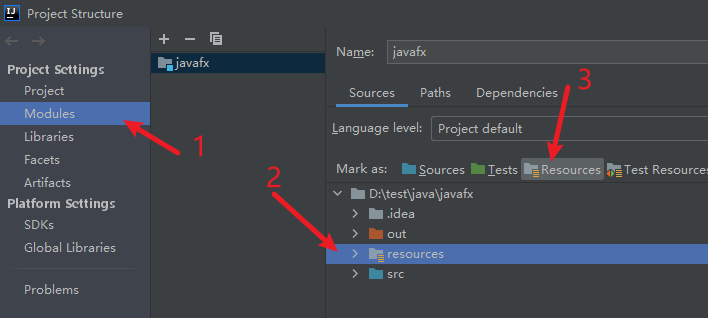
设置右键FXML文件打开SceneBuilder
确保已安装 SceneBuilder
从 Gluon 官网 下载并安装 SceneBuilder
在 IntelliJ IDEA 中配置:
文件(File) > 设置(Settings) > 语言和框架(Languages & Frameworks) > JavaFX 2. 在 "SceneBuilder 路径" 中指定你的 SceneBuilder 可执行文件路径 3. 应用设置后,右键点击 FXML 文件即可看到 "Open in SceneBuilder" 选项
如图:
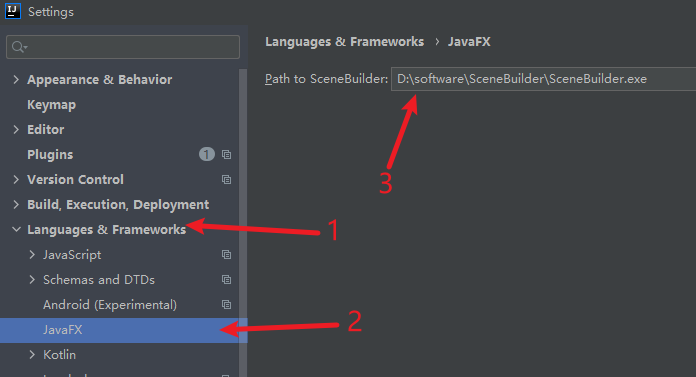
路径问题
纯Java项目图片资源路径问题
我的目录结构如图:

生产环境使用(推荐使用)
// 给场景设置鼠标图片,用来替换原鼠标样式
scene1.setCursor(new ImageCursor(new Image(getClass().getResourceAsStream("/image/cursor.png"))));
// 设置窗口图标
stage.getIcons().add(new Image(getClass().getResourceAsStream("/image/logo.png")));调试测试时使用(不推荐使用)
// 给场景设置鼠标图片,用来替换原鼠标样式
scene1.setCursor(new ImageCursor(new Image("file:resources/image/cursor.png")));
// 设置窗口图标
stage.getIcons().add(new Image("image/logo.png"));Maven项目
以下案例全都是在你配置了maven之后的路径
<resource> <!--把src/main/java目录下的properties、xml文件打包打进程序中--> <directory>src/main/java</directory> <includes> <include>**/*.properties</include> <include>**/*.xml</include> <include>**/*.fxml</include> </includes> <filtering>false</filtering> </resource>
加载FXML文件
Pane root = FXMLLoader.load(getClass().getResource("/vip/linfeng/test/modules/home/fxml/DataBaseHome.fxml"));
Scene scene = new Scene(root);你可以封装个工具类来简化代码:
public class FilePathUtils {
/**
* 获取FXML的绝对路径
* @param module 模块路径
* @param fxmlName FXML文件名称
* @return 返回FXML文件的绝对路径
*/
public static String getFXMLPath(String module, String fxmlName) {
return String.format("/site/hsdj/accessexcel/modules/%s/fxml/%s.fxml", module, fxmlName);
}
}使用:
Pane root = FXMLLoader.load(getClass().getResource(FilePathUtils.getFXMLPath("home", "DataBaseHome")));
